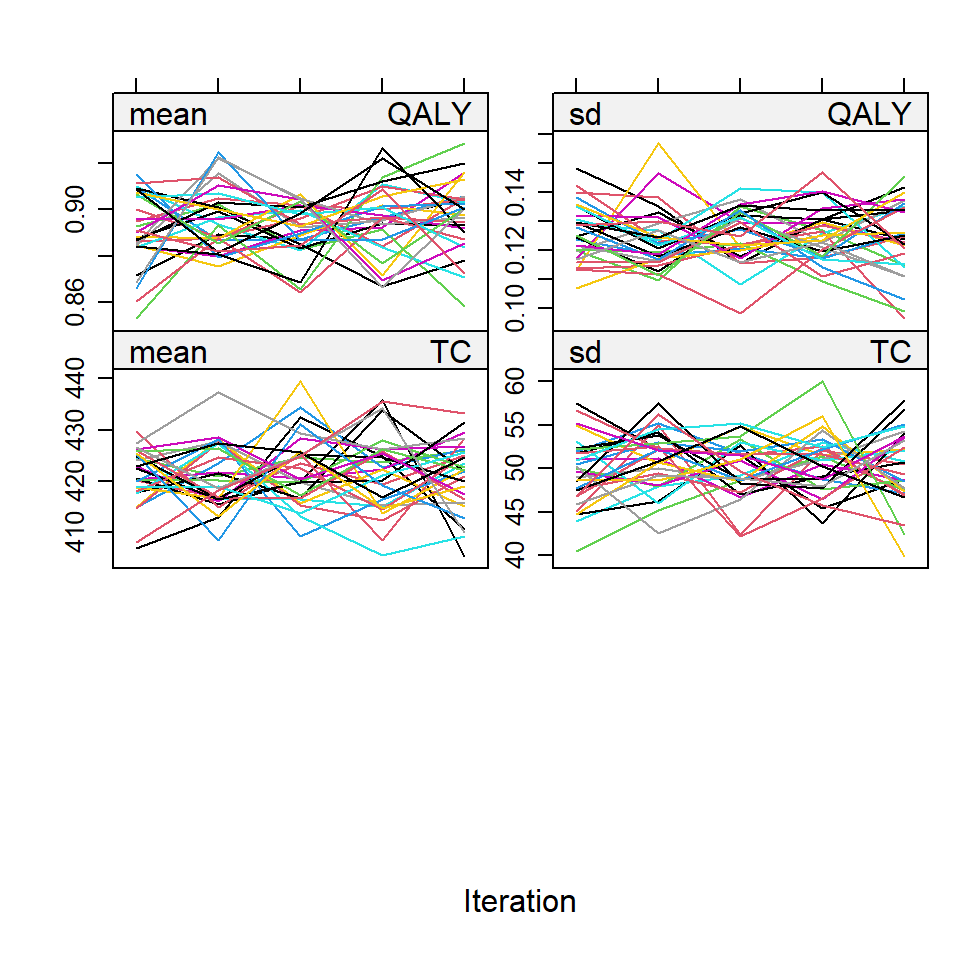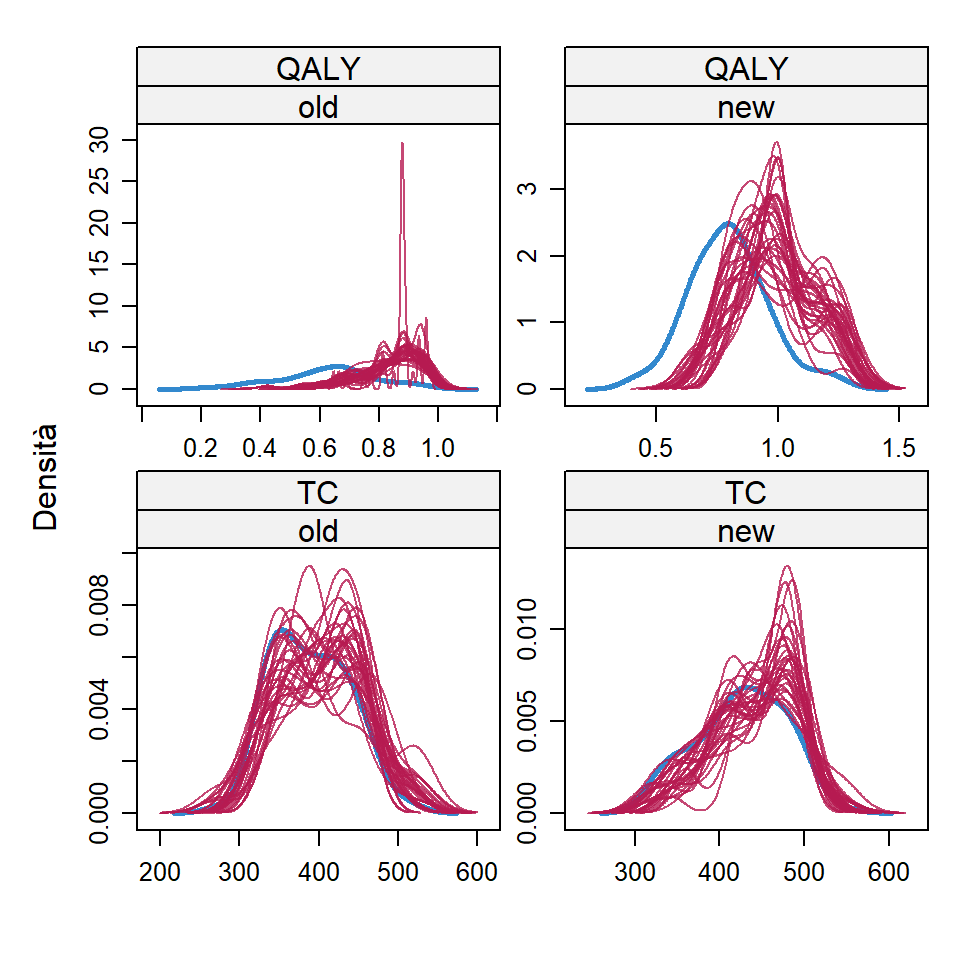Achana, Felix, Daniel Gallacher, Raymond Oppong, Sungwook Kim, Stavros Petrou, James Mason, and Michael Crowther. 2021. “Multivariate Generalized Linear Mixed-Effects Models for the Analysis of Clinical Trial–Based Cost-Effectiveness Data.” Medical Decision Making 41 (6): 667–84.
Allison, Paul. 2015. “Imputation by Predictive Mean Matching: Promise & Peril.” Statistical Horizons.
Baio, Gianluca. 2014. “Bayesian Models for Cost-Effectiveness Analysis in the Presence of Structural Zero Costs.” Statistics in Medicine 33 (11): 1900–1913.
Baio, Gianluca, Howard Thom, and Petros Pechlivanoglou. 2025. R for Health Technology Assessment. CRC Press.
Barber, Julie A, and Simon G Thompson. 2000. “Analysis of Cost Data in Randomized Trials: An Application of the Non-Parametric Bootstrap.” Statistics in Medicine 19 (23): 3219–36.
Barber, Julie, and Simon Thompson. 2004. “Multiple Regression of Cost Data: Use of Generalised Linear Models.” Journal of Health Services Research & Policy 9 (4): 197–204.
Ben, Ângela Jornada, Johanna M van Dongen, Mohamed El Alili, Martijn W Heymans, Jos WR Twisk, Janet L MacNeil-Vroomen, Maartje de Wit, Susan EM van Dijk, Teddy Oosterhuis, and Judith E Bosmans. 2023. “The Handling of Missing Data in Trial-Based Economic Evaluations: Should Data Be Multiply Imputed Prior to Longitudinal Linear Mixed-Model Analyses?” The European Journal of Health Economics 24 (6): 951–65.
Ben, Ângela Jornada, Johanna M van Dongen, Mohamed El Alili, Jonas L Esser, Hana Marie Broulı́ková, and Judith E Bosmans. 2023. “Conducting Trial-Based Economic Evaluations Using r: A Tutorial.” Pharmacoeconomics 41 (11): 1403–13.
Black, William C. 1990. “The CE Plane: A Graphic Representation of Cost-Effectiveness.” Medical Decision Making 10 (3): 212–14.
Brand, Jaap, Stef van Buuren, Saskia le Cessie, and Wilbert van den Hout. 2019. “Combining Multiple Imputation and Bootstrap in the Analysis of Cost-Effectiveness Trial Data.” Statistics in Medicine 38 (2): 210–20.
Briggs, Andrew H, Christopher Z Mooney, and David E Wonderling. 1999. “Constructing Confidence Intervals for Cost-Effectiveness Ratios: An Evaluation of Parametric and Non-Parametric Techniques Using Monte Carlo Simulation.” Statistics in Medicine 18 (23): 3245–62.
Briggs, Andrew H, David E Wonderling, and Christopher Z Mooney. 1997. “Pulling Cost-Effectiveness Analysis up by Its Bootstraps: A Non-Parametric Approach to Confidence Interval Estimation.” Health Economics 6 (4): 327–40.
Brooks, Steve, Andrew Gelman, Galin Jones, and Xiao-Li Meng. 2011. Handbook of Markov Chain Monte Carlo. CRC press.
Carpenter, James R, Jonathan W Bartlett, Tim P Morris, Angela M Wood, Matteo Quartagno, and Michael G Kenward. 2023. Multiple Imputation and Its Application. John Wiley & Sons.
Conigliani, Caterina, and Andrea Tancredi. 2009. “A Bayesian Model Averaging Approach for Cost-Effectiveness Analyses.” Health Economics 18 (7): 807–21.
Dı́az-Ordaz, K, Michael G Kenward, and Richard Grieve. 2014. “Handling Missing Values in Cost Effectiveness Analyses That Use Data from Cluster Randomized Trials.” Journal of the Royal Statistical Society Series A: Statistics in Society 177 (2): 457–74.
Drummond, Michael F, Mark J Sculpher, Karl Claxton, Greg L Stoddart, and George W Torrance. 2015. Methods for the Economic Evaluation of Health Care Programmes. Oxford university press.
El Alili, Mohamed, Johanna M van Dongen, Jonas L Esser, Martijn W Heymans, Maurits W van Tulder, and Judith E Bosmans. 2022. “A Scoping Review of Statistical Methods for Trial-Based Economic Evaluations: The Current State of Play.” Health Economics 31 (12): 2680–99.
Faria, Rita, Manuel Gomes, David Epstein, and Ian R White. 2014. “A Guide to Handling Missing Data in Cost-Effectiveness Analysis Conducted Within Randomised Controlled Trials.” Pharmacoeconomics 32 (12): 1157–70.
Fenwick, Elisabeth, Karl Claxton, and Mark Sculpher. 2001. “Representing Uncertainty: The Role of Cost-Effectiveness Acceptability Curves.” Health Economics 10 (8): 779–87.
Gabrio, Andrea, Michael J Daniels, and Gianluca Baio. 2020. “A Bayesian Parametric Approach to Handle Missing Longitudinal Outcome Data in Trial-Based Health Economic Evaluations.” Journal of the Royal Statistical Society Series A: Statistics in Society 183 (2): 607–29.
Gabrio, Andrea, Rachael Hunter, Alexina J Mason, and Gianluca Baio. 2021. “Joint Longitudinal Models for Dealing with Missing at Random Data in Trial-Based Economic Evaluations.” Value in Health 24 (5): 699–706.
Gabrio, Andrea, Alexina J Mason, and Gianluca Baio. 2017. “Handling Missing Data in Within-Trial Cost-Effectiveness Analysis: A Review with Future Recommendations.” PharmacoEconomics-Open 1 (2): 79–97.
———. 2019. “A Full Bayesian Model to Handle Structural Ones and Missingness in Economic Evaluations from Individual-Level Data.” Statistics in Medicine 38 (8): 1399–1420.
Glick, Henry A, Jalpa A Doshi, Seema S Sonnad, and Daniel Polsky. 2014. Economic Evaluation in Clinical Trials. OUP Oxford.
Gomes, Manuel, Karla Dı́az-Ordaz, Richard Grieve, and Michael G Kenward. 2013. “Multiple Imputation Methods for Handling Missing Data in Cost-Effectiveness Analyses That Use Data from Hierarchical Studies: An Application to Cluster Randomized Trials.” Medical Decision Making 33 (8): 1051–63.
Gomes, Manuel, Richard Grieve, Richard Nixon, Edmond S-W Ng, James Carpenter, and Simon G Thompson. 2012. “Methods for Covariate Adjustment in Cost-Effectiveness Analysis That Use Cluster Randomised Trials.” Health Economics 21 (9): 1101–18.
Gomes, Manuel, Edmond S-W Ng, Richard Grieve, Richard Nixon, James Carpenter, and Simon G Thompson. 2012. “Developing Appropriate Methods for Cost-Effectiveness Analysis of Cluster Randomized Trials.” Medical Decision Making 32 (2): 350–61.
Graham, John W, Allison E Olchowski, and Tamika D Gilreath. 2007. “How Many Imputations Are Really Needed? Some Practical Clarifications of Multiple Imputation Theory.” Prevention Science 8 (3): 206–13.
Grieve, Richard, Richard Nixon, and Simon G Thompson. 2010. “Bayesian Hierarchical Models for Cost-Effectiveness Analyses That Use Data from Cluster Randomized Trials.” Medical Decision Making 30 (2): 163–75.
Incerti, Devin, Howard Thom, Gianluca Baio, and Jeroen P Jansen. 2019. “R You Still Using Excel? The Advantages of Modern Software Tools for Health Technology Assessment.” Value in Health 22 (5): 575–79.
Indurkhya, Alka, Nandita Mitra, and Deborah Schrag. 2006. “Using Propensity Scores to Estimate the Cost–Effectiveness of Medical Therapies.” Statistics in Medicine 25 (9): 1561–76.
Lambert, Paul C, Lucinda J Billingham, Nicola J Cooper, Alex J Sutton, and Keith R Abrams. 2008. “Estimating the Cost-Effectiveness of an Intervention in a Clinical Trial When Partial Cost Information Is Available: A Bayesian Approach.” Health Economics 17 (1): 67–81.
Leurent, Baptiste, Manuel Gomes, and James R Carpenter. 2018. “Missing Data in Trial-Based Cost-Effectiveness Analysis: An Incomplete Journey.” Health Economics 27 (6): 1024–40.
Leurent, Baptiste, Manuel Gomes, Suzie Cro, Nicola Wiles, and James R Carpenter. 2020. “Reference-Based Multiple Imputation for Missing Data Sensitivity Analyses in Trial-Based Cost-Effectiveness Analysis.” Health Economics 29 (2): 171–84.
Leurent, Baptiste, Manuel Gomes, Rita Faria, Stephen Morris, Richard Grieve, and James R Carpenter. 2018. “Sensitivity Analysis for Not-at-Random Missing Data in Trial-Based Cost-Effectiveness Analysis: A Tutorial.” Pharmacoeconomics 36 (8): 889–901.
Ling, Xiaoxiao, Andrea Gabrio, Alexina Mason, and Gianluca Baio. 2022. “A Scoping Review of Item-Level Missing Data in Within-Trial Cost-Effectiveness Analysis.” Value in Health 25 (9): 1654–62.
Little, Roderick JA, and Donald B Rubin. 2019. Statistical Analysis with Missing Data. John Wiley & Sons.
Manca, Andrea, Neil Hawkins, and Mark J Sculpher. 2005. “Estimating Mean QALYs in Trial-Based Cost-Effectiveness Analysis: The Importance of Controlling for Baseline Utility.” Health Economics 14 (5): 487–96.
Manca, Andrea, and Stephen Palmer. 2005. “Handling Missing Data in Patient-Level Cost-Effectiveness Analysis Alongside Randomised Clinical Trials.” Applied Health Economics and Health Policy 4 (2): 65–75.
Marshall, Andrea, Lucinda J Billingham, and Stirling Bryan. 2009. “Can We Afford to Ignore Missing Data in Cost-Effectiveness Analyses?” The European Journal of Health Economics 10 (1): 1–3.
Mason, Alexina J, Manuel Gomes, James Carpenter, and Richard Grieve. 2021. “Flexible Bayesian Longitudinal Models for Cost-Effectiveness Analyses with Informative Missing Data.” Health Economics 30 (12): 3138–58.
Mason, Alexina J, Manuel Gomes, Richard Grieve, and James R Carpenter. 2018. “A Bayesian Framework for Health Economic Evaluation in Studies with Missing Data.” Health Economics 27 (11): 1670–83.
Nederland, Zorginstituut. 2024. “Guideline for Economic Evaluations in Healthcare (2024 Version).” Zorginstituut Nederland: Diemen.
Ng, Edmond SW, Karla Diaz-Ordaz, Richard Grieve, Richard M Nixon, Simon G Thompson, and James R Carpenter. 2016. “Multilevel Models for Cost-Effectiveness Analyses That Use Cluster Randomised Trial Data: An Approach to Model Choice.” Statistical Methods in Medical Research 25 (5): 2036–52.
Nixon, Richard M, and Simon G Thompson. 2005. “Methods for Incorporating Covariate Adjustment, Subgroup Analysis and Between-Centre Differences into Cost-Effectiveness Evaluations.” Health Economics 14 (12): 1217–29.
Nixon, Richard M, David Wonderling, and Richard D Grieve. 2010. “Non-Parametric Methods for Cost-Effectiveness Analysis: The Central Limit Theorem and the Bootstrap Compared.” Health Economics 19 (3): 316–33.
Noble, Sian Marie, William Hollingworth, and Kate Tilling. 2012. “Missing Data in Trial-Based Cost-Effectiveness Analysis: The Current State of Play.” Health Economics 21 (2): 187–200.
O’Hagan, Anthony, and John W Stevens. 2001. “A Framework for Cost-Effectiveness Analysis from Clinical Trial Data.” Health Economics 10 (4): 303–15.
———. 2003. “Assessing and Comparing Costs: How Robust Are the Bootstrap and Methods Based on Asymptotic Normality?” Health Economics 12 (1): 33–49.
Schafer, Joseph L, and John W Graham. 2002. “Missing Data: Our View of the State of the Art.” Psychological Methods 7 (2): 147.
Schomaker, Michael, and Christian Heumann. 2018. “Bootstrap Inference When Using Multiple Imputation.” Statistics in Medicine 37 (14): 2252–66.
Sekhon, Jasjeet Singh, and Richard D Grieve. 2012. “A Matching Method for Improving Covariate Balance in Cost-Effectiveness Analyses.” Health Economics 21 (6): 695–714.
Stinnett, Aaron A, and John Mullahy. 1998. “Net Health Benefits: A New Framework for the Analysis of Uncertainty in Cost-Effectiveness Analysis.” Medical Decision Making 18 (2_suppl): S68–80.
Thompson, Simon G, and Julie A Barber. 2000. “How Should Cost Data in Pragmatic Randomised Trials Be Analysed?” Bmj 320 (7243): 1197–1200.
Thompson, Simon G, and Richard M Nixon. 2005. “How Sensitive Are Cost-Effectiveness Analyses to Choice of Parametric Distributions?” Medical Decision Making 25 (4): 416–23.
Van Asselt, Antoinette DI, Ghislaine APG Van Mastrigt, Carmen D Dirksen, Arnoud Arntz, Johan L Severens, and Alfons GH Kessels. 2009. “How to Deal with Cost Differences at Baseline.” Pharmacoeconomics 27 (6): 519–28.
Van Buuren, Stef, and Stef Van Buuren. 2012. Flexible Imputation of Missing Data. Vol. 10. CRC press Boca Raton, FL.
White, Ian R, and John B Carlin. 2010. “Bias and Efficiency of Multiple Imputation Compared with Complete-Case Analysis for Missing Covariate Values.” Statistics in Medicine 29 (28): 2920–31.
White, Ian R, and Simon G Thompson. 2005. “Adjusting for Partially Missing Baseline Measurements in Randomized Trials.” Statistics in Medicine 24 (7): 993–1007.
Willan, Andrew R, Andrew H Briggs, and Jeffrey S Hoch. 2004. “Regression Methods for Covariate Adjustment and Subgroup Analysis for Non-Censored Cost-Effectiveness Data.” Health Economics 13 (5): 461–75.



